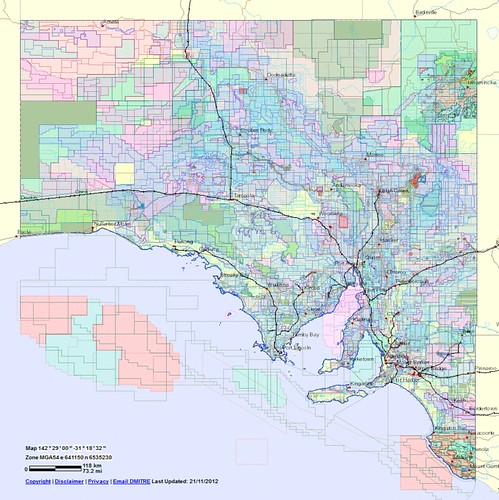
South Australia showing all current and historical mineral and petroleum tenements - somewhere under there is the state's reserve system!
Mining in reserves in SA - the state of play
Let's take a short tour through the state of South Australia, looking at the current situation regarding the mining industry's access to its reserve system - the national and conservation parks, game and regional reserves, and other flavours of protected area(All these maps were created using SARIG - the South Australian Resources Information Geoserver - an excellent tool for desktop research. The whole set of images can be viewed in sequence as a slideshow, with a more extended and detailed commentary, on my Flickr site.)
Firstly, the good news - here's the fully protected areas:
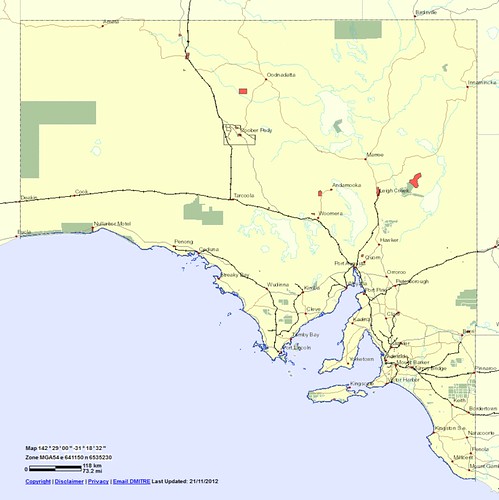
The olive-drab areas are those parts of the reserve system from which the mining industry is completely excluded. The special area that fully-protects the Arkaroola Wilderness Sanctuary is visible as the irregular red area immediately north of the fully-protected Vulkathunha/Gammon Ranges National Park east of Leigh Creek
Fully protected areas (olive drab) are shown above, as are areas excluded from the Mining Act (in red). Some of the latter are mines themselves(!), but one, I'm pleased to say, is the Arkaroola Wilderness Sanctuary - a recent and personal victory for many reading this - which is, in turn, adjacent to the fully-protected Vulkathunha National Park, once threatened by magnesite miners, and whose consolidation in its rightful, fully-protected, status required a long campaign at the turn of the century.(If you look at the map at the head of the post you can see the outlines of historic exploration leases, which, given their extensive overlapping, reveal that many of the now fully-protected Wilderness Areas had previously been determined to be unprospective!)
Next we'll add those reserves to which the industry has 'restricted' access - a comforting term, but still a name for mineable parks, nonetheless!
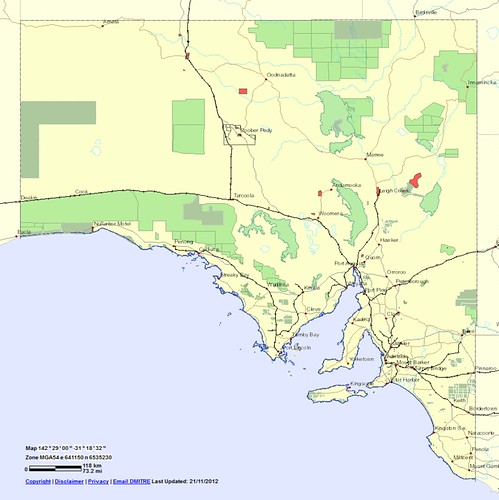
The light green areas are those parts of the reserve system to which the mining industry has access
Woah! Well, there's the bulk of the state's parks, appearing in light green. The industry still has access to roughly 3/4 of their land area.So, are they using it?
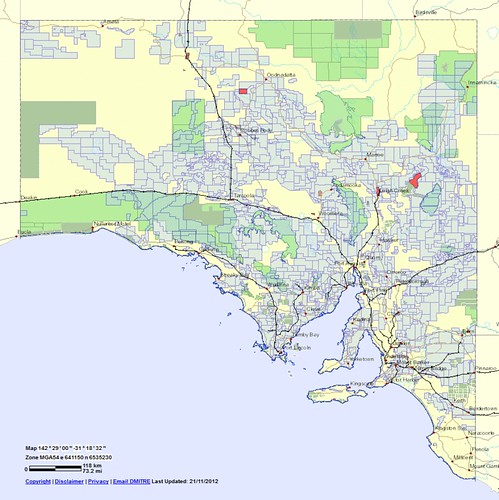
The light blue overlay indicates current mineral - and only mineral - exploration licences.
Yes. We can now see the current mineral exploration licences, and if we turn to consider mineral exploration licence applications...
The pink overlay indicates current mineral exploration licence applications.
...we see that these tenements are extensive, not only across the state, but across its reserves. And if we factor in historic mineral exploration leases?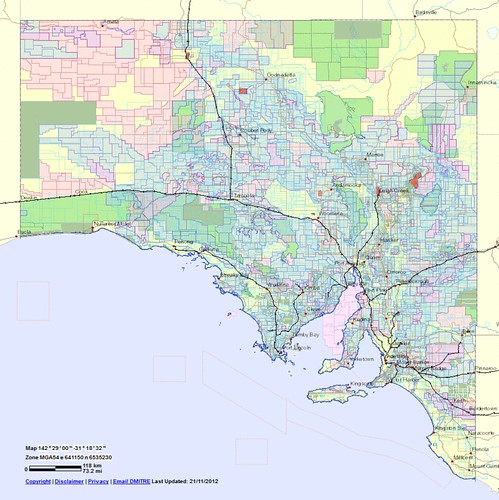
The sky blue outlines indicate all historic mineral exploration licences.
I'm sure you'll forgive me for observing that this all doesn't exactly look excessively 'hemmed in', 'locked out', or 'overly regulated' to me! If anything, we might perhaps consider the reverse...don't forget the petrol!
But we have yet to consider the petroleum side of the equation, so lets clear the mineral tenements and run through the current petroleum exploration leases -

The pale aqua overlay indicates current petroleum - and only petroleum - exploration licences.
Yes, petroleum leases are vast, when compared to their rocky counterparts! They also tend to cover the north-east of the state, which is not usually a mineral target.So, let's add the petroleum exploration lease applications...
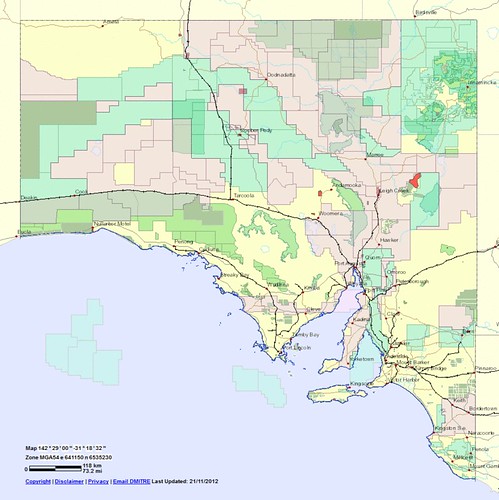
The puce layer indicates current petroleum exploration licence applications
...and we see that the bulk of the state and the available reserve system is now covered. It just remains to reveal the historic petroleum exploration leases...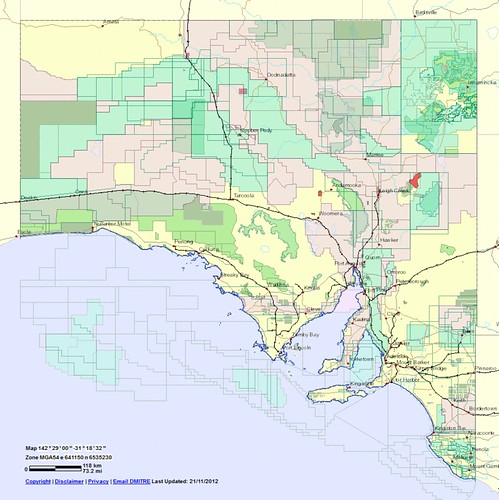
The dark teal outline indicates historic petroleum exploration licences
...and then we can re-examine the image at the top of the post, which includes all exploration tenements for both the mineral and petroleum arms of the mining industry - but not, I will note, the gas sector - plus all current and historic production tenements -
Phew! Yes, both the state and its reserve system are largely subsumed.
what's in a name?
And this is interesting in the light of the state government's recently proposed amendments overhauling the reserve category system to provide consistency with International Union for the Conservation of Nature (IUCN) categories, adding the category of a 'Nature Park' to the existing National and Conservation Parks to cover those reserves where the mining industry is to be given access (the existing category of 'Regional Reserve' will be retained where the pastoral industry is also permitted to operate.)What does this mean? Well, you can read it for yourself, but aside from us 'gaining' 67 such 'Nature Reserves' it means that, if the amendments are passed, the number of Conservation Parks will decline from 261 to 222, Recreation Parks from 14 to 6, and National Parks from 21 to 19 - but this is interesting, because by rights that number should actually be 16!
But instead we get, for example, this remarkable statement -
In response to community concerns regarding the potential impact on tourism if reclassified as a Nature Reserve, this park will remain in the National Park category and will continue to provide for existing and future mining rights.So, folks, when is a National Park not a National Park?
If a wild area is of so much importance to the community, to the state's ecosystem, and to our tourism economy, that it merited being designated as a National Park in the first place, why, oh why, must the mining industry be given access to it? And is it not hypocritical to insist that, yes, they must be allowed access, but then not admit that in reality this hitherto icon is actually only a 'Nature Reserve'?
I'll be producing a post specifically focusing on a couple of the parks in question shortly. I really cannot imagine a world where the public is ever going to accept their being mined, so I cannot see why we have to leave ourselves open to future Arkaroola-type struggles. It's not even in the mining industry's best interest! As you can see, it already has the run of the state; why does it continue to insist on getting access to some of our premier landscape jewels, too?
For the time being, see if you can spot on the maps above some of the state's most prominent National Parks that are either substantially, or significantly, light green - that is, accessible to the mining industry.
I've included some hints below. Public responses on the new categories can be made up until Friday 21st December.

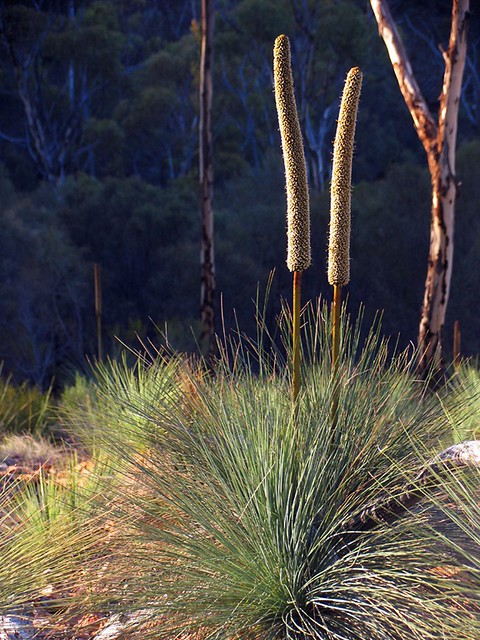
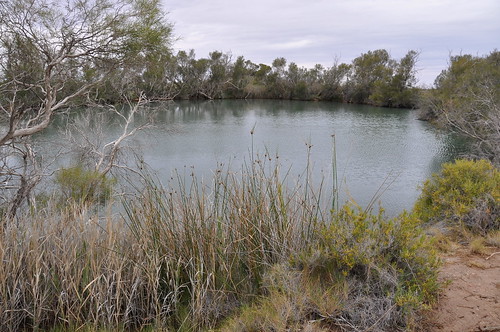

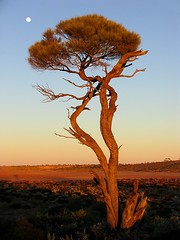
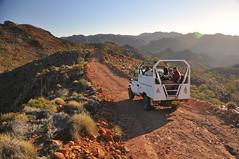
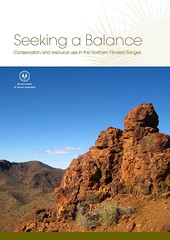
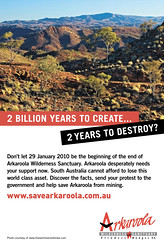
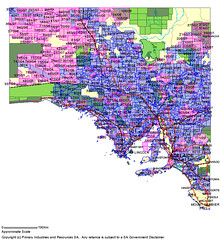
![link to the u[n]sa homepage](http://users.chariot.net.au/~greenh/blog/unknownsa_ublog-text.gif)


![link to the u[n]sa features page](http://users.chariot.net.au/~greenh/blog/features_ublog-text.gif)
![link to the u[n]sa kangaroo island feature image pages](http://farm2.static.flickr.com/1306/1187313059_93fdefd86b_o.jpg)
![link to the u[n]sa katarapko creek / murray river np feature image pages](http://farm2.static.flickr.com/1435/1181073355_b5c45f799d_o.jpg)


!['constellation' - wild country [national] set on flickr](http://farm1.static.flickr.com/155/415123844_3e6da621e5_s.jpg)

!['the bay serene' - the wild west [coast] set on flickr](http://farm1.static.flickr.com/121/312226516_606ac35455_s.jpg)








![u[n]sa journal -thanks for your time! u[n]sa journal - thanks for your time!](http://users.chariot.net.au/~greenh/blog/journal_ublog-text.gif)